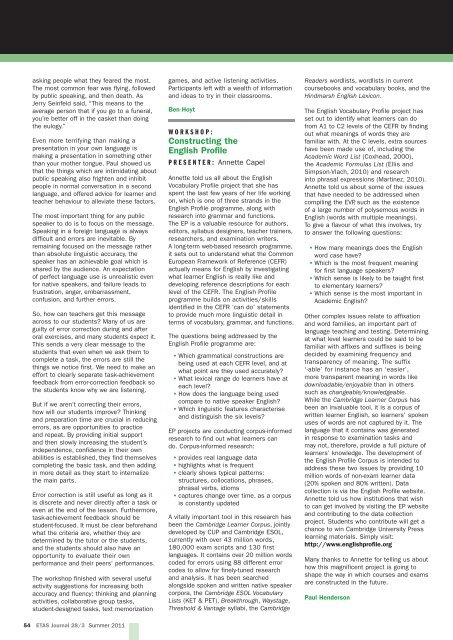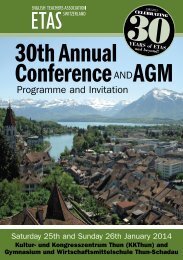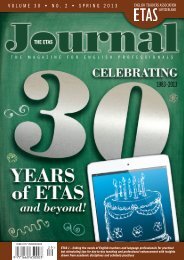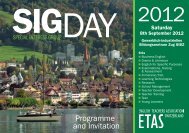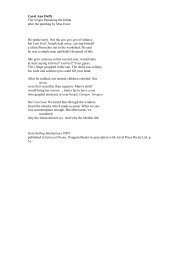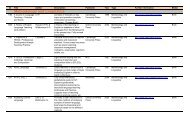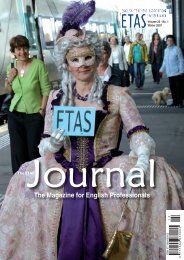Teaching English to Young Learners - English Teachers Association ...
Teaching English to Young Learners - English Teachers Association ...
Teaching English to Young Learners - English Teachers Association ...
Create successful ePaper yourself
Turn your PDF publications into a flip-book with our unique Google optimized e-Paper software.
asking people what they feared the most.<br />
The most common fear was flying, followed<br />
by public speaking, and then death. As<br />
Jerry Seinfeld said, “This means <strong>to</strong> the<br />
average person that if you go <strong>to</strong> a funeral,<br />
you’re better off in the casket than doing<br />
the eulogy.”<br />
Even more terrifying than making a<br />
presentation in your own language is<br />
making a presentation in something other<br />
than your mother <strong>to</strong>ngue. Paul showed us<br />
that the things which are intimidating about<br />
public speaking also frighten and inhibit<br />
people in normal conversation in a second<br />
language, and offered advice for learner and<br />
teacher behaviour <strong>to</strong> alleviate these fac<strong>to</strong>rs.<br />
The most important thing for any public<br />
speaker <strong>to</strong> do is <strong>to</strong> focus on the message.<br />
Speaking in a foreign language is always<br />
difficult and errors are inevitable. By<br />
remaining focused on the message rather<br />
than absolute linguistic accuracy, the<br />
speaker has an achievable goal which is<br />
shared by the audience. An expectation<br />
of perfect language use is unrealistic even<br />
for native speakers, and failure leads <strong>to</strong><br />
frustration, anger, embarrassment,<br />
confusion, and further errors.<br />
So, how can teachers get this message<br />
across <strong>to</strong> our students? Many of us are<br />
guilty of error correction during and after<br />
oral exercises, and many students expect it.<br />
This sends a very clear message <strong>to</strong> the<br />
students that even when we ask them <strong>to</strong><br />
complete a task, the errors are still the<br />
things we notice first. We need <strong>to</strong> make an<br />
effort <strong>to</strong> clearly separate task-achievement<br />
feedback from error-correction feedback so<br />
the students know why we are listening.<br />
But if we aren’t correcting their errors,<br />
how will our students improve? Thinking<br />
and preparation time are crucial in reducing<br />
errors, as are opportunities <strong>to</strong> practice<br />
and repeat. By providing initial support<br />
and then slowly increasing the student’s<br />
independence, confidence in their own<br />
abilities is established, they find themselves<br />
completing the basic task, and then adding<br />
in more detail as they start <strong>to</strong> internalize<br />
the main parts.<br />
Error correction is still useful as long as it<br />
is discrete and never directly after a task or<br />
even at the end of the lesson. Furthermore,<br />
task-achievement feedback should be<br />
student-focused. It must be clear beforehand<br />
what the criteria are, whether they are<br />
determined by the tu<strong>to</strong>r or the students,<br />
and the students should also have an<br />
opportunity <strong>to</strong> evaluate their own<br />
performance and their peers’ performances.<br />
The workshop finished with several useful<br />
activity suggestions for increasing both<br />
accuracy and fluency: thinking and planning<br />
activities, collaborative group tasks,<br />
student-designed tasks, text memorization<br />
54 ETAS Journal 28/3 Summer 2011<br />
games, and active listening activities.<br />
Participants left with a wealth of information<br />
and ideas <strong>to</strong> try in their classrooms.<br />
Ben Hoyt<br />
W O R K S H O P :<br />
Constructing the<br />
<strong>English</strong> Profile<br />
P R E S E N T E R : Annette Capel<br />
Annette <strong>to</strong>ld us all about the <strong>English</strong><br />
Vocabulary Profile project that she has<br />
spent the last few years of her life working<br />
on, which is one of three strands in the<br />
<strong>English</strong> Profile programme, along with<br />
research in<strong>to</strong> grammar and functions.<br />
The EP is a valuable resource for authors,<br />
edi<strong>to</strong>rs, syllabus designers, teacher trainers,<br />
researchers, and examination writers.<br />
A long-term web-based research programme,<br />
it sets out <strong>to</strong> understand what the Common<br />
European Framework of Reference (CEFR)<br />
actually means for <strong>English</strong> by investigating<br />
what learner <strong>English</strong> is really like and<br />
developing reference descriptions for each<br />
level of the CEFR. The <strong>English</strong> Profile<br />
programme builds on activities/skills<br />
identified in the CEFR ‘can do’ statements<br />
<strong>to</strong> provide much more linguistic detail in<br />
terms of vocabulary, grammar, and functions.<br />
The questions being addressed by the<br />
<strong>English</strong> Profile programme are:<br />
• Which grammatical constructions are<br />
being used at each CEFR level, and at<br />
what point are they used accurately?<br />
• What lexical range do learners have at<br />
each level?<br />
• How does the language being used<br />
compare <strong>to</strong> native speaker <strong>English</strong>?<br />
• Which linguistic features characterise<br />
and distinguish the six levels?<br />
EP projects are conducting corpus-informed<br />
research <strong>to</strong> find out what learners can<br />
do. Corpus-informed research:<br />
• provides real language data<br />
• highlights what is frequent<br />
• clearly shows typical patterns:<br />
structures, collocations, phrases,<br />
phrasal verbs, idioms<br />
• captures change over time, as a corpus<br />
is constantly updated<br />
A vitally important <strong>to</strong>ol in this research has<br />
been the Cambridge Learner Corpus, jointly<br />
developed by CUP and Cambridge ESOL,<br />
currently with over 43 million words,<br />
180,000 exam scripts and 130 first<br />
languages. It contains over 20 million words<br />
coded for errors using 88 different error<br />
codes <strong>to</strong> allow for finely-tuned research<br />
and analysis. It has been searched<br />
alongside spoken and written native speaker<br />
corpora, the Cambridge ESOL Vocabulary<br />
Lists (KET & PET), Breakthrough, Waystage,<br />
Threshold & Vantage syllabi, the Cambridge<br />
Readers wordlists, wordlists in current<br />
coursebooks and vocabulary books, and the<br />
Hindmarsh <strong>English</strong> Lexicon.<br />
The <strong>English</strong> Vocabulary Profile project has<br />
set out <strong>to</strong> identify what learners can do<br />
from A1 <strong>to</strong> C2 levels of the CEFR by finding<br />
out what meanings of words they are<br />
familiar with. At the C levels, extra sources<br />
have been made use of, including the<br />
Academic Word List (Coxhead, 2000),<br />
the Academic Formulas List (Ellis and<br />
Simpson-Vlach, 2010) and research<br />
in<strong>to</strong> phrasal expressions (Martinez, 2010).<br />
Annette <strong>to</strong>ld us about some of the issues<br />
that have needed <strong>to</strong> be addressed when<br />
compiling the EVP, such as the existence<br />
of a large number of polysemous words in<br />
<strong>English</strong> (words with multiple meanings).<br />
To give a flavour of what this involves, try<br />
<strong>to</strong> answer the following questions:<br />
• How many meanings does the <strong>English</strong><br />
word case have?<br />
• Which is the most frequent meaning<br />
for first language speakers?<br />
• Which sense is likely <strong>to</strong> be taught first<br />
<strong>to</strong> elementary learners?<br />
• Which sense is the most important in<br />
Academic <strong>English</strong>?<br />
Other complex issues relate <strong>to</strong> affixation<br />
and word families, an important part of<br />
language teaching and testing. Determining<br />
at what level learners could be said <strong>to</strong> be<br />
familiar with affixes and suffixes is being<br />
decided by examining frequency and<br />
transparency of meaning. The suffix<br />
‘-able’ for instance has an ‘easier’,<br />
more transparent meaning in words like<br />
downloadable/enjoyable than in others<br />
such as changeable/knowledgeable.<br />
While the Cambridge Learner Corpus has<br />
been an invaluable <strong>to</strong>ol, it is a corpus of<br />
written learner <strong>English</strong>, so learners’ spoken<br />
uses of words are not captured by it. The<br />
language that it contains was generated<br />
in response <strong>to</strong> examination tasks and<br />
may not, therefore, provide a full picture of<br />
learners’ knowledge. The development of<br />
the <strong>English</strong> Profile Corpus is intended <strong>to</strong><br />
address these two issues by providing 10<br />
million words of non-exam learner data<br />
(20% spoken and 80% written). Data<br />
collection is via the <strong>English</strong> Profile website.<br />
Annette <strong>to</strong>ld us how institutions that wish<br />
<strong>to</strong> can get involved by visiting the EP website<br />
and contributing <strong>to</strong> the data collection<br />
project. Students who contribute will get a<br />
chance <strong>to</strong> win Cambridge University Press<br />
learning materials. Simply visit:<br />
http://www.englishprofile.org<br />
Many thanks <strong>to</strong> Annette for telling us about<br />
how this magnificent project is going <strong>to</strong><br />
shape the way in which courses and exams<br />
are constructed in the future.<br />
Paul Henderson


